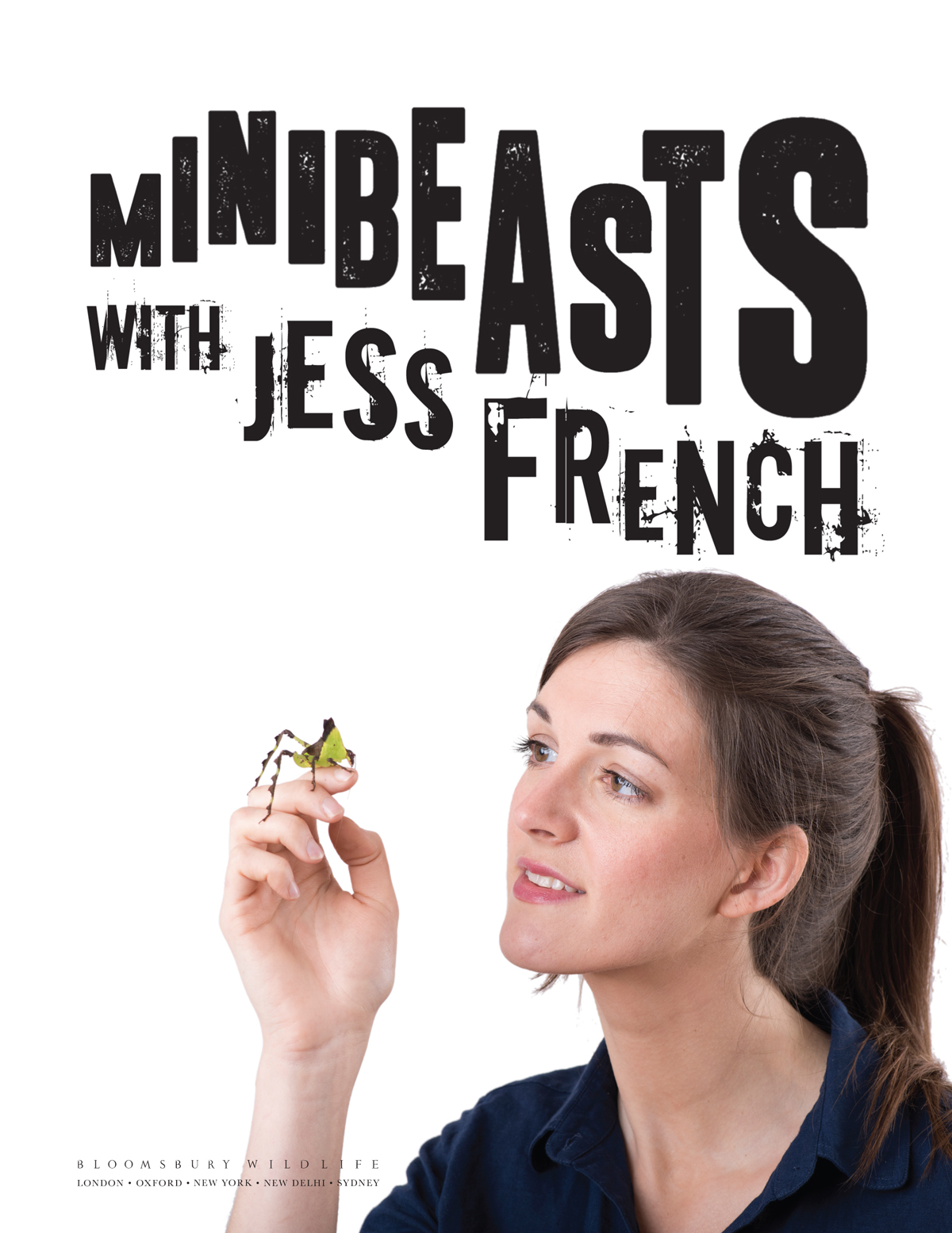Jess French - Minibeasts with Jess French
Here you can read online Jess French - Minibeasts with Jess French full text of the book (entire story) in english for free. Download pdf and epub, get meaning, cover and reviews about this ebook. year: 2018, publisher: Bloomsbury Publishing, genre: Detective and thriller. Description of the work, (preface) as well as reviews are available. Best literature library LitArk.com created for fans of good reading and offers a wide selection of genres:
Romance novel
Science fiction
Adventure
Detective
Science
History
Home and family
Prose
Art
Politics
Computer
Non-fiction
Religion
Business
Children
Humor
Choose a favorite category and find really read worthwhile books. Enjoy immersion in the world of imagination, feel the emotions of the characters or learn something new for yourself, make an fascinating discovery.
- Book:Minibeasts with Jess French
- Author:
- Publisher:Bloomsbury Publishing
- Genre:
- Year:2018
- Rating:5 / 5
- Favourites:Add to favourites
- Your mark:
- 100
- 1
- 2
- 3
- 4
- 5
Minibeasts with Jess French: summary, description and annotation
We offer to read an annotation, description, summary or preface (depends on what the author of the book "Minibeasts with Jess French" wrote himself). If you haven't found the necessary information about the book — write in the comments, we will try to find it.
Minibeasts with Jess French — read online for free the complete book (whole text) full work
Below is the text of the book, divided by pages. System saving the place of the last page read, allows you to conveniently read the book "Minibeasts with Jess French" online for free, without having to search again every time where you left off. Put a bookmark, and you can go to the page where you finished reading at any time.
Font size:
Interval:
Bookmark:

For my dad, Martin, who introduced me to the magical world of minibeasts and for Fenya, who still has it all to discover.
BLOOMSBURY WILDLIFE
Bloomsbury Publishing Plc
50 Bedford Square, London, WC1B 3DP, UK
This electronic edition published in 2018 by Bloomsbury Publishing Plc
BLOOMSBURY, BLOOMSBURY WILDLIFE and the Diana logo are trademarks of Bloomsbury Publishing Plc
First published in Great Britain 2018
Text copyright Jess French, 2018
Photographs, including cover photographs, copyright as detailed , 2018
Jess French has asserted her right under the Copyright, Designs and Patents Act, 1988, to be identified as Author of this work
For legal purposes the constitute an extension of this copyright page
All rights reserved
You may not copy, distribute, transmit, reproduce or otherwise make available this publication (or any part of it) in any form, or by any means (including without limitation electronic, digital, optical, mechanical, photocopying, printing, recording or otherwise), without the prior written permission of the publisher. Any person who does any unauthorised act in relation to this publication may be liable to criminal prosecution and civil claims for damages.
A catalogue record for this book is available from the British Library
Library of Congress Cataloguing-in-Publication data has been applied for
ISBN: 978-1-4729-3955-5 (PB)
ISBN: 978-1-4729-3954-8 (eBook)
ISBN: 978-1-4729-3953-1 (ePDF)
Designs by Gridlock
To find out more about our authors and their books please visit www.bloomsbury.com where you will find extracts, author interviews and details of forthcoming events, and to be the first to hear about latest releases and special offers, sign up for our newsletter.

Contents

INT RODUCING MINIBEASTS
Before we begin our adventure into the fascinating world of minibeasts, heres a quick note about the slightly more boring science of taxonomy. To make sense of our amazing world, scientists have devised excellent ways of classifying how all our different creatures fit together by sorting them into separate groups. Invertebrates which are animals lacking a backbone are broadly classified into the categories below, according to how complicated their tissues and body systems are.

The word minibeast has no place in science its a non-taxonomic term, so there are no strict rules about what it does and doesnt include, and scientists seem to dislike it. However, I think its the perfect word to describe the fascinating and bizarre species that populate the minute invertebrate world. It depicts these animals precisely as they are: tiny, enchanting monsters with huge characters and incredible superpowers.
My definition of minibeast can be stretched to cover any of the invertebrates that fit into this taxonomic tree above, but I have spent vastly more time studying arthropods, annelids, flatworms and molluscs than any of the other, more obscure groups. Thats quite simply because those are the easiest minibeasts to observe (I dont often come across sponges, jellyfish and single-celled organisms in my day-to-day minibeast interactions!). If youre interested to learn more about the other phyla on the taxonomic tree, Ive included short definitions for them within the , where youll also find definitions for other specialist minibeasts terms I use throughout this book.
The four invertebrate groups Im going to focus on in this book are:
Annelids are segmented worms, such as earthworms, ragworms and leeches. They dont have legs or a hard skeleton, and their bodies are split into many small segments. They are excellent swimmers and burrowers, which means they can live in freshwater, marine and terrestrial environments. They are extremely sensitive to drying out, so they cannot survive in areas with little moisture.
Flatworms are ribbon-shaped, flat-bodied worms. They have a very basic body plan, with no respiratory or circulatory systems and a crude nervous system. Many flatworms are parasites that live in or on other animals.
Molluscs are soft-bodied invertebrates that sometimes have calcium carbonate shells. They generally dont have any segments and often have a tongue mounted with hundreds of tiny teeth, called a radula. Some molluscs, such as slugs and snails, have one big, muscular foot. Other molluscs, such as squids and octopuses, have multiple tentacles.
Arthropods are invertebrates with exoskeletons. This external skeleton allows them to have jointed appendages and survive in dry areas, but it also means that they must periodically moult their skin in order to grow. Arthropods are further divided into groups depending on the number of legs they have:

Left: Insects (6 legs)
Right: Arachnids (8 legs)

Left: Crustaceans (1014 legs)
Right: Myriapods (more than 20 legs)
Minibeasts are a wildly diverse and successful bunch, and are found almost everywhere in the world. Although individually small, the minibeast total population and biomass vastly outnumbers that of their vertebrate counterparts. These are the species that shape the way our planet looks, functions and perpetuates they pollinate plants, decompose dung, spread seeds, and provide food for birds, fish and mammals. Without invertebrates our world simply would not function.
Not only are minibeasts vital to the running of our planet, but they also demonstrate behaviours that are virtually unbelievable. While I could dedicate this entire book just to the ecological importance of minibeasts, instead I hope to introduce you to some of the weirdest and most fascinating members of the minibeast world, and to expose you to a few of their strangest behaviours through the breathtaking photos, masses of amazing facts and profiles of incredible species in the pages ahead. So lets dive into the mindblowing world of the minibeast!

E AT
Invertebrates can be found almost everywhere on the planet, so it is no surprise that theyve adapted to exploit an incredible array of food sources. We commonly associate minibeasts with the destruction of crops, but there are many ingenious invertebrates that feast on much more interesting foodstuffs than lettuces and tomatoes!
There are minibeasts with fantastic mouthparts that help them get their food, yet the most basic of invertebrate digestive systems is little more than a sack and a hole. The hole allows food to enter and leave the body, and the sack is full of enzymes that digest the food. More complex minibeasts have two holes, connected by a tube. The most intricate of invertebrate body systems include sensory palps cutting, shearing and sucking mouthparts and the ability to tolerate and recycle toxins.
Font size:
Interval:
Bookmark:
Similar books «Minibeasts with Jess French»
Look at similar books to Minibeasts with Jess French. We have selected literature similar in name and meaning in the hope of providing readers with more options to find new, interesting, not yet read works.
Discussion, reviews of the book Minibeasts with Jess French and just readers' own opinions. Leave your comments, write what you think about the work, its meaning or the main characters. Specify what exactly you liked and what you didn't like, and why you think so.












